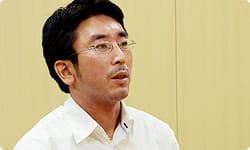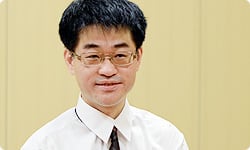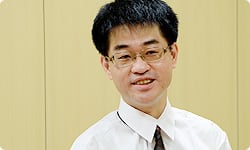Fifteen Years of Emotion
Today I'd like to ask you about Wii U Chat, Wii U console's video chat function, or TV phone, if you will. First off, please introduce yourselves.
I'm Tamiya from the Network Business Department, and I was in charge of direction on Wii U Chat.
I'm Watanabe from the Design Technology Group. I was in charge of the library1 for Wii U Chat. Thank you for having me today. 1. Library: When a program with a certain function is standardized and turned into a component to be read by another program. A library cannot work on its own, it only functions as part of a program.
Watanabe-san, you're coming from the Design Technology Group, which is a very small section within the Integrated Research and Development Division, which makes Nintendo hardware. Your department performs research on all kinds of technology for possible use in future games, and Wii U Chat was one of those.
Yes, that's correct.
Could the two of you tell me how Wii U Chat came about?
Well, (Genyo) Takeda-san2 had been interested in pursuing a TV phone type capability for years, and we in the Integrated Research and Development Division thought that we wanted to add that capability one day. 2. Genyo Takeda: Senior Managing Director of Nintendo and General Manager of the Integrated Research and Development Division. He is responsible for hardware development at Nintendo. In the past, he has appeared in sessions of Iwata Asks about the Wii hardware, the Wii Remote, Punch-Out!! and the Wii U console.
Yes. I actually remember hearing a lot about Takeda-san's feelings on that subject back during the era of the Nintendo 643 system, which would have been about 15 years ago, before I was with Nintendo. (laughs) Just like the caricature concept4 with Miyamoto-san, it was a theme that Takeda-san has been churning for a long time.
3. Nintendo 64: A home video game console released in June 1996.
4. Caricature concept: Shigeru Miyamoto's concept of creating caricatures of yourself and people you know so they can be used in video games. This concept has been realized with the Mii Channel on the Wii console.
So as the development of Wii U was moving along, and we began talking about adding a camera, we began to look into communication technology with NTD5 and Vidyo6 an American company that specialized in video conferencing systems. And then around the end of last year, we concluded that we might be able to make it work.
5. NTD (Nintendo Technology Development Inc.): A technology research and development group led by Howard Cheng based in Washington state.
6. Vidyo, Inc.: A video conferencing systems manufacturer established in the US in 2005.
The Wii U GamePad has an internal camera, but it doesn't have an external camera. So that means it's placed there with the intentions of it being used on something like a video conferencing software. How did you end up working with Vidyo?
Vidyo mainly provides video conferencing systems for business use, and Takeda-san knew someone who worked there.
Takeda—san certainly seem to have a lot of connections around the world you can say that the Takeda connection does it again, right? (laughs) What part of Vidyo's technology was particularly superior?
Let me try to give a simple example. When there's trouble with the network during a video chat, you get block noise.7 7. Block noise: A type of compression artifact occurring in a digital video, where the image looks pixilated.
Yes, you do. Depending on the degree of Internet congestion, things like how fast the data can be transmitted, and how much likelihood of error it will have are not guaranteed and changes dynamically depending on such factors as how many people are accessing to it at one time. So when something is wrong with the connection like being congested, with typical video compression technology you will see block noise artifacts and video interruption.
With Vidyo's technology, their communication method is capable of monitoring the connection status in real time and dynamically adjusts the signal to the optimum bitrate so there are minimum amount of interruptions. Because of this, when there's a problem with the network, the resolution is lowered slightly, but you can still watch the video without noticing much of a difference. I think that's a huge thing.
Internet communication takes place within an unstable environment, so if there's a difference in the speed at which the information is sent and received, part of the data may not be received. They are using their technology to cover so there won't be a breakdown, no matter the situation.
Yes. Within Japan, there's been an increase in areas with a good network environment, so you may not notice it as much. But overseas there are still a lot of areas with older lines, and it enables you to be able to keep a certain level of quality to all video chats, even those with someone in one of those areas.
It makes me want to have everyone make friends overseas so they can test it out.
Also, once the connection has initiated, we made it so that the rest of the session can go on without it contacting the server. Being able to use a P2P8 connection allowed for a system to have a less likelihood of a problem occurring even when many people around the world use it. 8. P2P connection: An abbreviation for "peer-to-peer" communication. It is a method of data communication where each user's terminals can connect and communicate directly, rather than have the communication relayed by a server. There are systems that are completely based off of a P2P connection where it takes longer to initiate a connection, and a supernode type where the communication requires intervention of a third party terminal. Wii U Chat utilizes a hybrid type where the initial connection is established by help of a server, and from there the two units would communicate directly.
I see, otherwise server fees would incur and we wouldn't be able to offer this service at no additional cost. By the way, Tamiya-san, did you come into things after the technological foundations were established?
That's right. I had received notification from NOA (Nintendo of America) that a team at NLG (Next Level Games)9 whom we had close connection with, had an open line. They asked if there was anything we could do with it, and we were just investigating, "Maybe we could do built-in video chat?" It fit with the project, so we decided to pursue it officially. 9. NLG (Next Level Games Inc.): A video game development company based in Vancouver, BC. In the past they have worked on games such as Super Mario Strikers (GC), Mario Strikers Charged (Wii), and Punch-Out!! (Wii). Currently there are working on Luigi's Mansion: Dark Moon for the Nintendo 3DS system.
Tamiya-san, could you tell the people reading this interview what you did before this?
Before this, I created the Nintendo Zone Viewer10, which is a viewer for the Nintendo Zone service for the Nintendo 3DS system. 10. Nintendo Zone Viewer: A viewer on the Nintendo 3DS™ system to search for local areas where Nintendo Zone™ service is enabled.
The Nintendo Zone Viewer was actually developed in collaboration with an overseas company, right?
Yes. We developed it with the Project Engineering Department, which was one of the departments at NOA.
When it comes to working with people from overseas, you've got that language barrier, and there are usually a lot of cultural differences. Didn't that make communication difficult?
That's true. So this time, we had a bilingual staff member from NOA who used to work with us on technology programming of Nintendo Zone Viewer to help coordinate things for us, which helped us out tremendously in that regard.
Even though, there are times where you must meet face to face to align direction. To do that you went there several times.
Right, about every three months, I had to go to stay there to meet face to face with the team so we could align direction. Going there did allow the project to move along efficiently, but it also helped in my being able to understand the teams overseas, like their characters and their ways of thinking. Knowing those things helped quite a bit after I came back to Japan, when we continued talking via email and when we held video meetings.
I may be exaggerating, but I think feelings that can come across between emails and an actual visit are quite a bit different. A video meeting would be right in between the two.
Oh, that's exactly the Mehrabian's rule that was discussed in the Iwata Asks: Miiverse: The Developers. It's hard to get your emotions across with language information alone like in emails. In that sense, with a "TV phone", while it doesn't replace actually meeting in person, as long as you've met, you can get much more across than just communicating over the phone or by email. Tamiya-san, you continued development feeling this first-hand.
Yeah, working on this project made me realized just how important being able to talk while you look at their faces is.
Also, with this software, the director was Japanese, but most of the members were overseas, so this project was made the opposite way that we usually do things: the overseas version was made first and then localized for Japan.
Yes. A subsidiary near NOA called NST11 (Nintendo Software Technology) cooperated with us in localizing the English version into the Japanese one. 11. NST (Nintendo Software Technology): A subsidiary of Nintendo based in Washington State.
Previously, when developing software for hardware at the same time with hardware development, departments within Nintendo Japan were in charge of the majority of development, but leveraging Tamiya-san's previous experience, we are now able to work together with a lot of teams like this on what used to be handled with just the internal teams. By the way, Watanabe-san, were you able to smoothly integrate Vidyo's technology into Wii U?
No, that actually took some doing. The software was structured modularly so it was easy to build it in to the Wii U library, but even though, being a business-oriented technology, it had great track record with computers, but this was the first time it was applied on a video game console.
Game consoles don't have the breadth of features and libraries that are a matter of course to an OS12 on a computer. That's the fun, and the challenging part of building an embedded system13.
12. OS: Software in charge of the entire computer system.
13. Embedded System: A computer system initially built in to perform specific functions. Compared to a generic system for PC, in the case of video game hardware, these systems need to be specifically built for the hardware.
That's right. Especially because during the early phases of development, things like the Wii U OS and the network functionalities weren't in their final form. At the start of this year we had Silicon Studio14 in Tokyo help us out with the optimizing the moving parts. And then we were somehow able to meet the deadline for this schedule. 14. Silicon Studio Cooperation: A developer mainly involved in the development of middleware for game content. Established in 2000.
I'm sure if you had done all that work yourselves, it would have either taken a lot longer, or it would have affected being able to develop the software internally. So this project really made good use of past connections and chance encounters we had with others.



